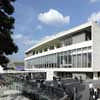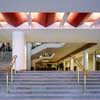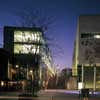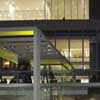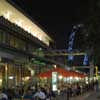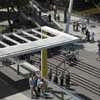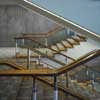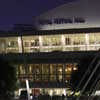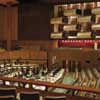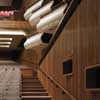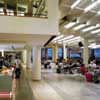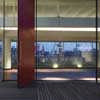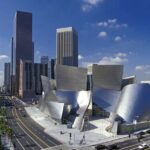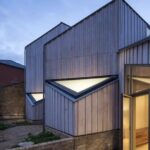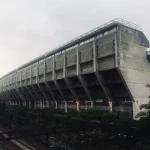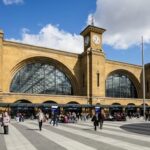Royal Festival Hall, London Southbank Centre Building Refurbishment, Photos, Architect, Pictures
Royal Festival Hall London : Architecture
Royal Festival Hall Renewal, Southbank Centre – design by Allies and Morrison Architects
13 Jun 2009
Royal Festival Hall
Project: Royal Festival Hall refurbishment, Southbank Centre, central London
Design: Allies and Morrison Architects
Context images with London Eye
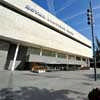
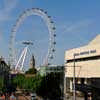

photographs © Nick Weall
Royal Festival Hall Renovation : Winner of a RIBA National Award 2008
Few buildings in Britain generate the public affection given to the Royal Festival Hall. The transformation project has been an opportunity to refurbish this extraordinary building; its clarity of function, composition and organisation; its detail, materials, colour and lighting. The Royal Festival Hall was the first significant public building built after the war and the first modernist building to be Grade I Listed. This recognition came however, at a time when it had become almost unrecognisable, through first radical and later careless change. On one level the project has been a recovery of the clarity of the original plan, its theory and composition. On another it has been about the management of change.
This change has affected every fibre of the Royal Festival Hall building’s fabric. The building has a new setting, a thriving public realm, radically different from 1951 yet closer in spirit than at any time since. Its foyers have been rediscovered; the plethora of Southbank Centre administrative offices moved to the ‘New Building’ alongside the railway. The Royal Festival Hall auditorium has been transformed, almost every surface removed and ‘retuned’ to live up to the acoustic aspirations the original designers acknowledged they never quite achieved, and to provide the production facilities and audience comfort of a concert hall for the new century.
The building reached the Stirling Prize Shortlist 2008.
Royal Festival Hall Building – Introduction
The opening of the Royal Festival Hall (RFH) in 1951 heralded the artistic revival of post war Britain. Some 50 years later this landmark building has been reopened after 2 years’ refurbishment, the culmination of 15 years design work since Allies and Morrison’s appointment as house architect in 1992.
Over time, the clarity of the original concept had been eroded; by the radical changes of 1963-64, and the later incursion of offices and retail outlets. The increasing range of events in the auditorium was no longer well served. By the 1990’s, RFH had become one of the busiest concert halls in the world, but the fifty year old building was in need of major repair and refurbishment.
Public realm
The project has reshaped the entire environment surrounding the RFH from Queen’s Walk on the riverfront to Belvedere Road. Queen’s Walk has been linked by new stone steps to a line of shops, cafes and bars created out of the 1964 riverside extension.
Two new staircases; one internal, one external, sheltered by bright metal canopies link the riverfront and the upper level terrace, repopulated by a new riverside café and a new glass balustrade replaces the concrete barrier.
The busy route between Golden Jubilee footbridge and Waterloo is now lined with shops and cafes, housed in the New Building. This accommodates Southbank Centre’s administrative offices on the two upper floors and conceals all dedicated delivery bays and service areas in lower ground level railway arches.
Foyers
The transparency of the foyers and their flowing internal spaces were always distinctive elements of the Royal Festival Hall building. The refurbishment project recovered the clarity of circulation, reinstated the significance of original entrances on all sides of the building and cleared out the clutter of commercial units.
Important facilities have been returned to their original locations, if realised in new ways: the cloakroom with its new zigzag counters; new interval bars in the space facilitated by relocation of the offices.
At the top of the RFH building the roof terraces have been reinstated for public use. Enclosing the original concrete pergolas, two glass pavilions are now used throughout the year. A new glass lift gives, for the first time, access from the Waterloo entrance to all levels of the building.
The refurbishment of the fabric of the foyers, replacement of original 1950s carpets and reintroduction of original strong colours used on the walls, with the addition of new lighting, has revived the vibrancy of the spaces.
Auditorium
The Royal Festival Hall auditorium was almost totally dismantled and reassembled.
A core ambition was to achieve the originally unfulfilled acoustic ambitions and to reinstate RFH amongst the great concert halls of the world. The original goal was ‘long enough reverberation to give fullness of tone and strong enough direct sound to give definition.’ With expertise provided by Kirkegaard Associates, all linings have been removed, rebacked and reconnected to the concrete shell so that more sound is reflected to the audience.
A specific problem for performers was the difficulty of hearing each other on the platform. Both the angled ‘blast’ side walls and the plywood reflectors projected sound away from the stage. To overcome this problem, the platform area and organ chamber have been reconfigured, stage geometry altered and new stage lifts installed. The original plywood overstage canopy has been replaced by new adjustable fabric reflectors which reflect high frequency sound back to the stage immediately, giving precision, but are permeable to mid and low frequency sound, giving warmth.
Today’s demanding varied programme at the RFH has required a radical improvement in stage set-up, lighting and production. Turnaround has been streamlined by new backstage facilities: the stage has been re-configured and equipped with lifts that allow it to move in eleven separate sections; the choir benches can be wheeled out to provide a level floor for staged and dance performances; suspended above the stage, new lighting bridges give safe access to production equipment.
Robin Day’s auditorium seats from 1951 were remodelled and have been rebuilt, stripped back to the steel frames and reconstructed with reduced acoustic absorption. The space between seat rows has been extended by 75mm by rebuilding the concrete floor of the stalls, with a loss of only 118 seats. Cooling has been introduced by reversing the airflow in the auditorium.
The greatest accolade for the RFH project has been the endorsement of the reworked acoustics by a number of conductors and musicians.
The Royal Festival Hall was visited by 250,000 people on its reopening weekend. Its reopening season was heralded by unprecedented positive coverage, including 1,900 written articles.
The Royal Festival Hall has always been at the cultural heart of London. It is now seen as a concert hall worthy of the capital in a setting worthy of its festival beginnings.
Royal Festival Hall refurbishment images / information from Allies and Morrison Architects 030708
Royal Festival Hall – original structure
Date built: 1951
London County Council Architects’ Department
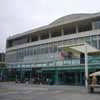
image © Adrian Welch
Permanent building from Festival of Britain
Location: Royal Festival Hall, London, England, UK
London Buildings
Contemporary London Architecture
London Architecture Designs – chronological list
London Architecture Walking Tours by e-architect
South Bank Centre – Buildings
Mies van der Rohe Award Nominee 2009
South Bank Centre Building : Royal National Theatre
Southbank Centre London : Redevelopment Masterplan
Shortlisted for Stirling Prize 2008
South Bank Centre Building designer : Denys Lasdun Architect
Comments / photos for the Royal Festival Hall London Architecture page welcome

